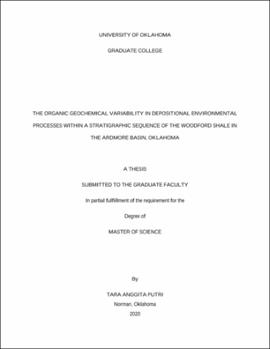| dc.description.abstract | The Devonian-Early Mississippian Woodford Shale underlying the subsurface of Carter and Murray Counties in the Ardmore Basin, Oklahoma, USA, has attracted growing interest as an unconventional reservoir. Heterogeneity has always been assumed within samples collected from different locations, while uniformity is often assumed in a stratigraphic sequence of the shale both in chemical and physical properties. However, the Woodford Shale is composed of characteristically different layers, a soft bed comprising of higher TOC, higher ductility and clay, as well as a hard layer that is lower in TOC, higher in brittleness and in silica content which greatly contributes to the variation in biomarker distributions. The bulk of the interval shows pristane/n-C17 vs. phytane/n-C18 ratios, C27/C29 sterane ratios, diasterane/sterane ratios, and Ts/Tm ratios indicating a reduced, marine depositional environment, low in maturity.
The variations between the soft and hard beds are responsible for the variability of the biomarkers rather than solely depth. These variations can be seen within the C30 hopanes that show higher values within the harder beds relative to the higher TOC softer beds. Samples have been taken at 6” intervals over a 40ft. outcrop of the Woodford shale to investigate variability in organic facies, source input, and depositional environment conditions.
Shale samples have been characterized by Rock-Eval to determine TOC and hydrocarbon potential to identify variations of biomarkers in TOC rich intervals and TOC lean intervals. Additionally, shale extracts were processed by gas chromatography (GC), gas chromatography-mass spectrometry (GC-MS) and GC-MS-MS to acquire biomarker traces that aid in the construction of paleoenvironmental conditions. Furthermore, the Frasnian-Famennian mass extinction which occurred at the Late Devonian is reflected to have occurred within this interval based on significant changes in the geochemical data. Variations in the biomarker distributions signify the heterogeneity of the shale over this 40ft interval, which in turn will yield fundamental information related to fine differences that affect reservoir quality in exploration and production of unconventional reservoirs. | en_US |
